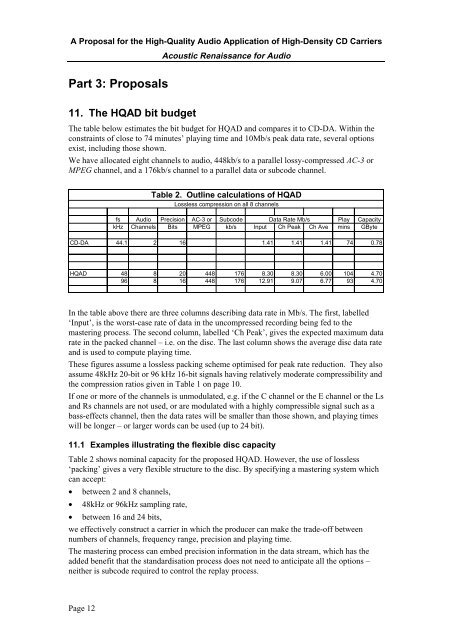A Proposal for the High-Quality Audio Application of High ... - Meridian
A Proposal for the High-Quality Audio Application of High ... - Meridian
A Proposal for the High-Quality Audio Application of High ... - Meridian
You also want an ePaper? Increase the reach of your titles
YUMPU automatically turns print PDFs into web optimized ePapers that Google loves.
A <strong>Proposal</strong> <strong>for</strong> <strong>the</strong> <strong>High</strong>-<strong>Quality</strong> <strong>Audio</strong> <strong>Application</strong> <strong>of</strong> <strong>High</strong>-Density CD Carriers<br />
Part 3: <strong>Proposal</strong>s<br />
11. The HQAD bit budget<br />
Page 12<br />
Acoustic Renaissance <strong>for</strong> <strong>Audio</strong><br />
The table below estimates <strong>the</strong> bit budget <strong>for</strong> HQAD and compares it to CD-DA. Within <strong>the</strong><br />
constraints <strong>of</strong> close to 74 minutes’ playing time and 10Mb/s peak data rate, several options<br />
exist, including those shown.<br />
We have allocated eight channels to audio, 448kb/s to a parallel lossy-compressed AC-3 or<br />
MPEG channel, and a 176kb/s channel to a parallel data or subcode channel.<br />
Table 2. Outline calculations <strong>of</strong> HQAD<br />
Lossless compression on all 8 channels<br />
fs <strong>Audio</strong> Precision AC-3 or Subcode Data Rate Mb/s Play Capacity<br />
kHz Channels Bits MPEG kb/s Input Ch Peak Ch Ave mins GByte<br />
CD-DA 44.1 2 16 1.41 1.41 1.41 74 0.78<br />
HQAD 48 8 20 448 176 8.30 8.30 6.00 104 4.70<br />
96 8 16 448 176 12.91 9.07 6.77 93 4.70<br />
In <strong>the</strong> table above <strong>the</strong>re are three columns describing data rate in Mb/s. The first, labelled<br />
‘Input’, is <strong>the</strong> worst-case rate <strong>of</strong> data in <strong>the</strong> uncompressed recording being fed to <strong>the</strong><br />
mastering process. The second column, labelled ‘Ch Peak’, gives <strong>the</strong> expected maximum data<br />
rate in <strong>the</strong> packed channel – i.e. on <strong>the</strong> disc. The last column shows <strong>the</strong> average disc data rate<br />
and is used to compute playing time.<br />
These figures assume a lossless packing scheme optimised <strong>for</strong> peak rate reduction. They also<br />
assume 48kHz 20-bit or 96 kHz 16-bit signals having relatively moderate compressibility and<br />
<strong>the</strong> compression ratios given in Table 1 on page 10.<br />
If one or more <strong>of</strong> <strong>the</strong> channels is unmodulated, e.g. if <strong>the</strong> C channel or <strong>the</strong> E channel or <strong>the</strong> Ls<br />
and Rs channels are not used, or are modulated with a highly compressible signal such as a<br />
bass-effects channel, <strong>the</strong>n <strong>the</strong> data rates will be smaller than those shown, and playing times<br />
will be longer – or larger words can be used (up to 24 bit).<br />
11.1 Examples illustrating <strong>the</strong> flexible disc capacity<br />
Table 2 shows nominal capacity <strong>for</strong> <strong>the</strong> proposed HQAD. However, <strong>the</strong> use <strong>of</strong> lossless<br />
‘packing’ gives a very flexible structure to <strong>the</strong> disc. By specifying a mastering system which<br />
can accept:<br />
• between 2 and 8 channels,<br />
• 48kHz or 96kHz sampling rate,<br />
• between 16 and 24 bits,<br />
we effectively construct a carrier in which <strong>the</strong> producer can make <strong>the</strong> trade-<strong>of</strong>f between<br />
numbers <strong>of</strong> channels, frequency range, precision and playing time.<br />
The mastering process can embed precision in<strong>for</strong>mation in <strong>the</strong> data stream, which has <strong>the</strong><br />
added benefit that <strong>the</strong> standardisation process does not need to anticipate all <strong>the</strong> options –<br />
nei<strong>the</strong>r is subcode required to control <strong>the</strong> replay process.


